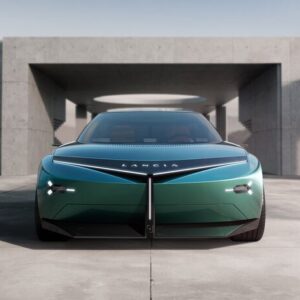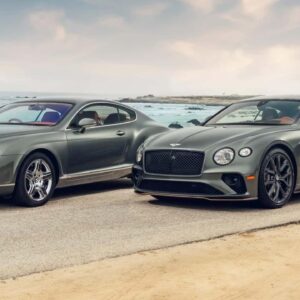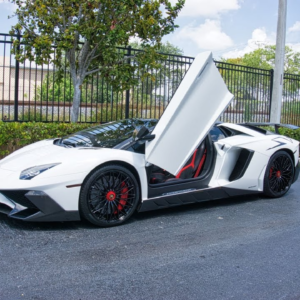The stunning Quattro-inspired EL1 is the work of Marcus Holzinger, a former VW exterior designer who founded ELegend in 2021.

Launched in 1980, the Audi Quattro coupe is a car that changed the world. Until the Quattro, all-wheel drive was considered useful only for off-road vehicles. But the Quattro, whose all-road, all-weather traction enabled it to utterly dominate the World Rally Championship in the Group B era, showed that driving all four wheels could make high-performance road cars even faster. There are few modern high-performance cars, from Toyota’s GR Corolla to Porsche’s 911 Turbo S to Tesla’s Model S Plaid to Bugatti’s Chiron, that don’t rely on all-wheel drive to deliver their other-worldly acceleration, cornering, and braking.

It’s no surprise, then, to learn the ELegend EL1, a 21st-century, electric-powered tribute to the short-wheelbase Audi Sport Quattro coupe launched in 1984, is all-wheel drive. Unlike the Sport Quattro, however, the ELegend EL1’s all-wheel drive system is not symmetrical: The rear wheels are powered by a 603 horsepower electric motor, while the fronts are driven by a 201 hp e-motor. You won’t have to have the driving talent of a Walter Rohrl to get the EL1 to drift.

The stunning EL1 is the work of Marcus Holzinger, a former VW exterior designer who founded ELegend in 2021. But what makes this reimagination of the Audi Sport Quattro even more interesting is that Holzinger’s father, Wolfgang, was a modeler at Audi before founding his own product design business, HOTE, in 1983. He was literally hands on developing the styling the original Quattro and Sport Quattro.

The EL1 is a masterclass in post-modern automotive design; its form and detailing and surfacing and stance are pure 21st century, yet immediately the homage to the Sport Quattro is obvious thanks to beautifully integrated cues such as the vent across the hood, the bulging fender flares, and the black line under the similarly shaped C-pillar that references the venting on the original car. But the proportions are very different: The EL1’s 96.3-inch wheelbase is 8.7 inches longer than that of the original Sport Quatro, yet the car is almost a half inch shorter overall, which means it has much shorter overhangs front and rear. The bodywork is also more smoothly teased out over a 4.2-inch wider track from a roof line that’s 2.9 inches lower.


It looks like a show car, inside and out. But what you see here, right down to the NACA duct-shaped glass panel in the roof, is pretty much what the production version of the EL1 will look like, says Holzinger. And, he says, a lot of work is going in to making sure the EL1 drives as good as it looks. “The biggest challenge in recent months has been the design-technology convergence, developing a rolling chassis that does not dilute our design idea of a modern Group B vehicle, yet offers performance that is second to none, compact dimensions, good ergonomics, and sufficient space.”

The lightweight carbon-fiber monocoque rolling chassis is being developed by Munich-based automotive engineering company, Roding Mobility. Aluminum subframes front and rear provide mounting points for the e-motors and their associated powertrain hardware, as well as the multi-link suspension components front and rear, and have been designed to allow the development of future ELegend derivatives on the same platform.

As mentioned, the EL1’s two e-motors develop a total of 804 hp. The front motor can produce a peak of 369 lb-ft of torque, while the rear develops a hefty 811 lb-ft. All that grunt, combined with a claimed curb weight of 3,946 pounds, light for an EV, means the EL1 will, says Holzinger, sprint from 0 to 60 mph in about 2.6 seconds, and to 124 mph in 7.5 seconds. Although both motors drive through single-speed transmission, the EL1’s claimed top speed is an attention-getting 186 mph.

Drivers will be able to switch between Standard and Sport mode in terms of the powertrain delivery, and three different suspension settings. To cope with its asymmetric power and torque distribution, the EL1 runs on a staggered wheel and tire setup, with 19-inch rims and 285/30 tires up front, and 20-inch rims and 305/30 tires on the rear axle.

That relatively low overall weight, 47 percent of which rests on the front axle and 53 percent on the rear, is in part the result of the EL1’s relatively small 80-kWh, T-shaped battery pack, which sits in the central tunnel and across the car behind the seats to help lower the car’s center of gravity. ELegend says those hungry e-motors will suck down electrons at the rate of about 2.96 mi/kWh. Target range, based on the generous European WLTP cycle is therefore about 240 miles. A battery cooling system means the car will be able to do two full-power laps of the 12.94-mile Nürburgring Nordschleife without any loss of performance, Holzinger says.
Just 30 EL1s will be hand-built with production starting next year, and the car will be available to U.S. customers. You’ll need deep pockets, though: Prices start at the equivalent of about $950,000, plus shipping and taxes.





